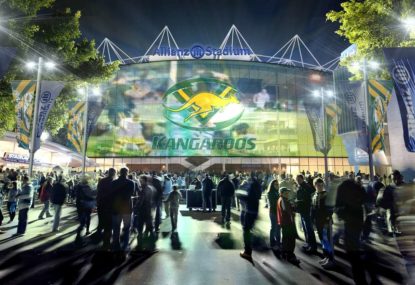For at least the past five years, there has been a seemingly endless debate surrounding Sydney’s stadiums and where NRL clubs should play. There is no simple answer.
Every suggestion has multiple positives and negatives, but some have more merit than others. So let’s delve straight into the solutions by starting with the Sydney Football Stadium, currently known as Allianz Stadium.
Allianz Stadium is fast entering a point of no return. It is a fantastic stadium with one of the best atmospheres in Australia and fantastic sightlines from almost anywhere in the ground.
It was designed in such a way that even when it is half full, the stadium is still buzzing. But it is now 26 years old and ageing rapidly. Many of the facilities are not adequate, the food, bar and toilet lines are often very long, and car parking is a major issue.
And although this may sound crazy given the decline in crowds experienced by the NRL and Waratahs, the 44,000 capacity is too small. The 40,000-seat disparity between Allianz Stadium and ANZ Stadium make major events more likely to choose ANZ over Allianz.
Everyone agrees that ANZ Stadium can be a terrible place to watch football from, but many administrators would rather 50,000 people and a sub-par atmosphere at ANZ Stadium than a full Allianz Stadium.
The problem with Allianz Stadium is that it was designed in such a manner that it is near impossible to increase the capacity by a considerable amount.
Many of the solutions suggested to improve Allianz Stadium are just band-aid solutions, including Wi-Fi access to allow spectators to order and receive food without leaving their seats, a roof so some soft spectators don’t get wet, and new toilets. These might see a rise in attendance for a small period of time, but this will not be sustainable.
A football stadium does not need a roof, ever. Football is an outdoor sport, and the elements play a role. As soon as a roof is put over a football stadium, one of the most important variables in sport is lost.
There will come a point when it is best to just raze the stadium to the ground and start from scratch by building a 55,000-seat stadium with an opportunity to increase to 80,000 if need be. The problem with this idea is funding, and the fact that the Roosters, Waratahs and Sydney FC will need a home for two to three years.
But delaying this construction of a new stadium will only cost more money in the long run, because we are wasting money on short-term fixes instead of spending big on one long-term solution. It is expected that the upgrades of Allianz Stadium will cost around $250 million, while the Beijing National Stadium (aka the Bird’s Nest) cost $450 million to build from scratch and ANZ Stadium cost $690 million to complete in 1999.
If this new Sydney Football Stadium is built, it has to be built as a purely rectangular stadium with a design that maximises atmosphere so that even if it is half full, the atmosphere is still electric. This will be the key to separating it from ANZ Stadium and making it one of the best sporting stadiums in Australia, if not the world.
With a bit of foresight and solid financial backing, the new Sydney Football Stadium can easily become a reality within the next five years. And since everybody on discussion boards and newspaper article comments whinges about ANZ Stadium, if the new stadium holds 80,000 people, this can become the new home of State of Origin and NRL grand finals.
Before you start calling me an Eastern Suburbs homer who hates travelling across the Anzac Bridge, I’ll explain to you the problems with the government’s plans for a marquee rectangular stadium in Sydney’s west.
The government, as a part of the NSW Government Stadia Strategy, is ending funding for suburban grounds and instead wants to invest money in new major stadiums. This could ultimately lead to funding for a new Sydney Football Stadium, and is the driving force behind the government’s desire for a 40,000-seat stadium in Sydney’s west which will be shared by Western Sydney’s football teams.
Currently, there are three areas and NRL clubs fighting for this stadium – the Parramatta Eels, the Penrith Panthers and the Wests Tigers – while the Eels and football’s Western Sydney Wanderers also have a back-up plan should this bid fail.
There are two major problems with this proposal. Firstly, if the Eels and Wanderers get the stadium in Parramatta, the Panthers are not going to leave their home in Penrith to play in this stadium in the heart of Eels territory. Likewise the Tigers, who are pushing for the stadium to be located in Campbelltown.
If the stadium is located in Parramatta, Penrith or Campbelltown, the two clubs that don’t get the stadium in their region will just continue playing at their current stadium. The Eels have made this known by creating their own proposal to increase the capacity of Pirtek Stadium if the new stadium is not built in Parramatta.
Secondly, Sydney’s west already has a marquee stadium. ANZ Stadium pays clubs, including Parramatta and the Tigers, to play there. These two clubs generated a crowd of 50,000 when they played each other this season – larger than the size of the proposed stadium – which means that many marquee match-ups would still be played at the larger ANZ Stadium.
I will discuss Sydney’s north and west, as well as ANZ Stadium, in more detail in parts two and three of this article.






























































































